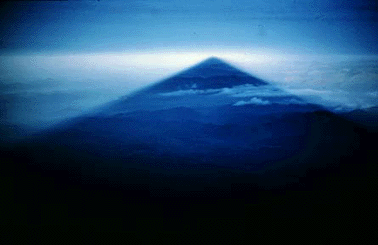
Mt. Fuji is a beautiful example of a stratovolcano, and is almost a perfect symmetric cone (at least when viewed from far away). It is mostly basalt, which is a little bit unusual for stratovolcanoes. Most stratovolcanoes are constructed of andesite or dacite compositions. The fact that it is a stratovolcano means that it is composed of layers of both lava and ash. The fact that it is such a beautiful cone probably indicates that it hasn’t recently suffered a big eruption.
“Volcanoes of the World” by Tom Simkin and Lee Seibert lists 63 eruptions of Mt. Fuji since about 9000 years ago. Obviously most of these have been determined by using carbon-14 dating rather than accounts by witnesses. However, the most recent 22 eruptions are listed as having been recorded by people. The most famous eruption was probably the one in 1707.
Mount Fuji is famous for it's perfectly symmetrical cone. This photograph shows the shadow of Fuji projected of the adjacent countryside at sunrise.
Image Credit: Robert Decker, May 1962